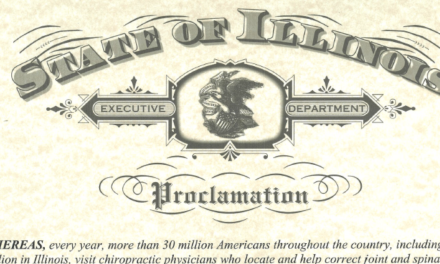
Medical Necessity Requirements

CMS Clarifies Medical Necessity Requirements
On December 23, 2015, the Centers for Medicare and Medicaid Services (CMS) released a new instructional video describing their policies and procedures for establishing the medical necessity requirements of chiropractic care.1 The video was released on the heels of a new study released by the Office of Inspector General (OIG), “CMS Should use Targeted Tactics to Curb Questionable and Inappropriate Payments for Chiropractic Services”2, which revealed extrapolated data suggesting fraud and abuse in chiropractic Medicare utilization. The video further clarifies the dilemma between Medicare regulations and the presenting complaints of the Medicare patent.
According to Medicare, in 2014, the rate of improper payment rate for chiropractic services was 54%.3 Much of the error rate was attributed to insufficient documentation. Every year the OIG report ranks the chiropractic profession as the leader in errors.
Under Medicare, covered services for chiropractic treatment is approved for treatment by means of manual manipulation of the spine to correct a subluxation. While this may seem simple, the care must also meet requirements for medical necessity.
Medically Necessary
According to the Social Security Act, section 1861(s)(10), reimbursement is approved for services that are deemed medically necessary for items or services that are reasonable and necessary for the diagnosis or treatment of illness or injury to improve the functioning of a malformed body member. In chiropractic services, manipulation is reimbursed for services covered under the CPT® codes: 98940 (manipulation to one to two regions of the spine); 98941 (manipulation to three to four regions of the spine); and 98942 (manipulation to five regions of the spine). The treatment must be documented and the medical necessity must be demonstrated.
“CPT Copyright 2017 American Medical Association. All rights reserved.
CPT® is a registered trademark of the American Medical Association.”
Documentation must support the need for treatment to the regions of the spine that are treated. This documentation must include the chief complaint and findings that are frequently found in the acronym P.A.R.T. To satisfy P.A.R.T., the doctor must document at least two of the following, pain or tenderness, misalignment or asymmetry, range of motion abnormality and tissue tone changes. One of these must either be misalignment/asymmetry or range of motion abnormality. P.A.R.T. must be segment specific and not merely by the region of the spine.
Documentation
In addition, components of medical necessity must be documented. In addition to the presence of a subluxation that causes a significant neuromusculoskeletal condition, the doctor must document the treatment plan.
In the treatment plan, the frequency and duration of care must be documented, and the specific treatment goals and objective measures to evaluate treatment effectiveness must also be in the record. In other words, as the treating doctor, you must document how long and how often they plan to treat the patient, what you are trying to accomplish and the criteria you will use to know when you have met those treatment goals.
Finally, the documentation must be signed by the doctor for each visit, and the signature must be legible. Some signatures are no more than a scribble. If this is the case for your signature, then you may elect to attach a signature log that shows who is signing the record and what that signature would look like.
Modifiers
When you file the claim, for the spinal manipulation codes you must append either an AT modifier to signify that the care is for active care or a GA modifier for maintenance care. You can no longer use the AT and GA modifier together (ATGA) since they are considered to be separate in meaning. If the code does not have a modifier appended to it, it will automatically be denied as a non-covered service.
Although most of our Medicare patients have chronic problems, active care is described as care that is to improve the “functioning” of the patient. Once that functional improvement has become stable or at maximum improvement, the care is no longer considered medically necessary and is therefore not a covered service. Medicare does not pay for services that seek to prevent disease, promote health and prolong and enhance the quality of life (wellness care), nor for care that is to maintain or prevent deterioration of a chronic condition (supportive care). Actually, most private health insurance plans do not pay for these types of services in the chiropractic scope of care.
Conclusion
The carrier must spot-check claims and ask for the notes periodically. However, if you do not respond in the time indicated in the request, the claim will automatically be denied. If you have a high number of denials, you may trigger a full investigation and audit.
Since Medicare beneficiaries make up 16% of the U.S. population, a high number of our patients are eligible for Medicare benefits. In view of the propensity for a Medicare patient to come into your office seeking care, and that you cannot opt out of Medicare and must file a claim for active care, it is incumbent for each of us to understand the Medicare documentation and medical necessity requirements.
References:
- www.Youtube.com, CMSHHSgov, December 23, 2015.
- http://oig.hhs.gov/oei/reports/oei-01-14-00200.asp
- https://www.cms.gov, U.S. DEPARTMENT OF HEALTH AND HUMAN SERVICES, The Supplementary Appendices for the Medicare Fee-for-Service 2014 Improper Payments Report, pg. 6.
Upcoming Courses
Dr. Fucinari and the ICS will be presenting several classes in the coming months to aid the doctor and staff in the implementation of the documentation and Medicare guidelines. For an updated schedule of classes and locations, go to www.ILchiro.org or www.AskMario.com. Dr. Fucinari is a Certified Medical Compliance Specialist and a Certified Professional Compliance Officer. He serves on the Medicare Carrier Advisory Committee. Dr. Fucinari is the author of several books and other resources, including, his latest publication, Compliance Program Manual for the Chiropractic Office, available at www.Askmario.com For further information on compliance audits, books or record reviews, please contact Dr. Fucinari at Doc@Askmario.com

















